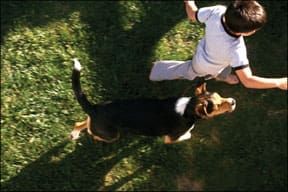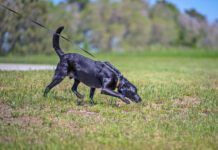[Updated January 28, 2019]
Dogs and kids can be the best of playmates. Sometimes they develop this relationship all on their own, and sometimes they need some outside assistance to become fast friends. It’s not uncommon for the basic dog-kid foundation to be solid, with just a few rough edges that need smoothing. One of the common rough spots is when your excited dog wants to chase after and nip your excited children. Here are five things you can do if your canine youngster wants to play a little too roughly with your human youngsters:

1. Supervise your dog diligently.
Dog trainers say it all the time: Never leave small children alone with even the most trustworthy dog. If you’re present when play starts to escalate out of control, step in and calm things down. Without your intervention, your dog gets reinforced for her inappropriate behavior. Chasing a squealing child is a very fun game! – at least for the dog, and sometimes for the child – until a bite happens. Behaviors that are reinforced are more likely to be repeated and to increase in intensity, and are harder to modify or extinguish.
2. Make Household Rules
Of course children need to be able to run around without worrying about a canine ambush. Set some firm house rules that are designed to minimize chase-and-nip games. If your dog loves kids, it’s fine to allow your small children and their friends to hang out with the dog (under direct supervision, of course); your older children and their friends can hang out with the dog with less supervision. In either case, one house rule should be that before rowdy play happens, the dog gets escorted to a safe place away from the action, and gets something wonderful (i.e., stuffed Kong) so she doesn’t feel punished. Another house rule is “absolutely no deliberately antagonizing the dog to encourage her to chase or nip.” Violation of these rules should result in loss of dog-companionship privileges for a pre-determined period.
3. Train Your Dog to Stay Off Kids
The better-trained your dog is, the easier it is for you to calmly and quickly intervene. A gentle “come” or “down” cue for a dog who is under good stimulus control is all it takes to abort the chase-and-nip game. Deliver high-value reinforcement when your wonderful dog responds immediately to your cue to keep those responses strong. Behaviors that are reinforced are more likely to repeated and repeated with enthusiasm.
4. Involve Your Children in the Training Program
The best way to train your children to interact appropriately with your dog is to include them in your dog’s training program. You can teach even very young children how to elicit a polite sit from your dog by raising their hands to their chest – if you’ve taught your dog this body-language signal to sit. Teach your young humans how to play “trade” with your dog by offering a treat or a toy to get her to give up something she has in her mouth, then encourage them to play games that direct her energy – and her teeth – toward something other than a child’s skin or clothing, such as a ball or Frisbee. The better you are at teaching your children what to do (and reinforcing them for it!), the more they will do what you want them to. Just like dogs!
5. Read Up on Dogs and Kids
Trainer/author/mother Colleen Pelar has written two excellent books on dog-kid relationships. Her first, Living with Kids and Dogs Without Losing Your Mind, is loaded with excellent advice for parents. Her second, Kids and Dogs; A Professional’s Guide to Helping Families, is written for those dog training professionals (like me) who don’t have human children of our own. If your trainer regularly instructs you to do things regarding your dog and child that you feel are unrealistic, read this book and then hand it off to her.
Of course, not all dogs love kids. If your basic dog-kid relationship foundation is shaky, then you need to do a whole lot more than the above five things. That’s an entirely different article! If that’s the case, don’t let them interact until you consult a good, positive behavior professional.







Hi,
I have a very friendly and excitable golden doodle and fortunately she loves all people, especially little kids. Unfortunately we are not around them often enough for me to do any consistent training with her to teach her that they are not puppies or squeaky toys that move. So every time we get around them she gets so overly excited if the kids run she will run after them, jump them, sometimes knock them to the ground and nip. Lately whenever we are around small children I keep her on the leash and next to me but she spends the entire time crying and letting out yelps and pulling on the leash to try and get to the kids. Which is not fun for me or her. Any advice on how to train her to behave better around kids when we aren’t around them constantly?
I have the EXACT same issue. I need help! The last camping trip the labradoodle broke 3 leashes chasing after kids. She is not aggressive at all, but her excitement is driving us crazy. She is so good when kids aren’t around, but as soon as she sees a child she is uncontrollable. I don’t even want to take her camping anymore. Help!